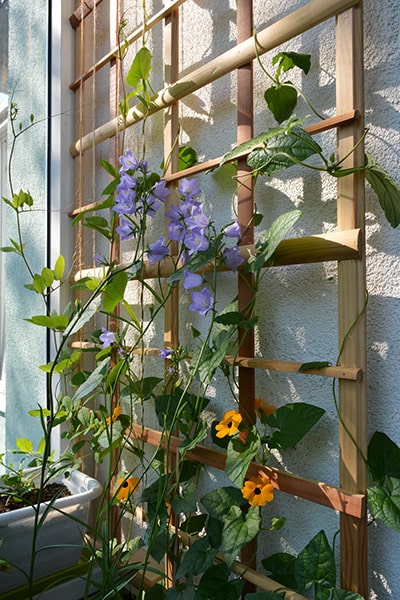
Trellising plants, fruits, and vegetables is a long-standing gardening technique that may be utilised for various reasons. Growing plants vertically on a trellis that produce fruits and vegetables is especially beneficial. Plants that climb do so with a wide range of versatility; they can climb by way of clawing and thorns, twining and hugging, suckering and rooting, or just flopping until some sort of climbing support is found by the plant. Plants that climb can be invasive and quite adventurous, but there are some that may be quite dainty as well. There are climbing plants available for all garden situations, including sunny, shady, damp, or dry. There are varieties of climbing plants that need space while others do well indoors and in limited space. Some climbing plants like to climb walls and fences while others can be grown as ground cover. The majority of climbing plants are shrubs or perennials while some are annuals. The list below highlights some of the best climbing plants, the benefits of growing vegetables vertically, and basic instructions for growing clematis and certain vegetables on a trellis.
Pruning Wisteria
This is a twining climbing plant that can be grown on a framework such as a trellis. Once it is established it will send out new shoots up to 2m long in a single season.
Solanum jasminoides Album
This is a great long-flowering evergreen climber. It is a superb choice because it flowers throughout the summer and with pruning it is easily controlled. It is an ideal plant for a trellis because it needs support since it is not a self-climber. It makes one of the best flowering floppy shrubs.
Campsis radicans
This plant accents a trellis during the mid-summer with showy orange-red flowers. It is a self-climber that grows quickly once it is established. The flowers can range in colour from pink through to the deepest scarlet. This plant likes the sun, but will also grow in light shade.
Vitis coignetiae
Huge heart shaped leaves is a key feature of this great climbing plant. The plant needs the support of a sturdy trellis, but will grow in any situation. The leaves of this plant will give spectacular autumn colours of gold through to the deepest orange.
Climbing Roses
These are widely recognised and very popular because they are so versatile. The variety of colours available is limited only by the imagination, including Perpetue, Pink, Golden Showers, Climbing Iceberg, and several others.
Clematis (including Clematis armandii / Evergreen clematis)
In February, this plant will produce pure white flowers. This plant is a good climber and ideal for growing on a trellis. In fact, there is a clematis plant for every season and just about any colour scheme. To train the plant to climb a trellis simply follow these basic guidelines:
- Untie the stems from the cane after planting. Then push four or five canes into the soil. They should be placed in the soil near the plant and angled towards the trellis. Secure the trellis end of the cane to the trellis with garden twine.
- Tie four or five of the main shoots to the canes
- The clematis shoots should then be allowed to grow vertically up the trellis. Side shoots can be tied-in to fill in any gaps.
Growing Vegetables up a Trellis
There are many advantages to growing vegetables vertically. The most obvious is that it takes less ground space, increasing the potential yield per square foot because more plants can fit into the garden. The trellis is an ideal support for growing these plants, making harvesting easier, reducing waste because fruit is less likely to be hidden from sight and become overripe, and making it easier to control pests. When growing these plants on a trellis there may be additional considerations. When placing the trellis in a garden, situate it at the north side of the garden to avoid shading other plants. Also, anchor the trellis posts about 24 inches deep so the trellis can handle the weight of the plants and to avoid damage from the wind.
Plants that can grow vertically include certain variations of tomatoes, peas, cucumbers, melons, squash, and pumpkins. Tomatoes are one of the most popular plants to trellis, but it is important to choose the correct type. There are determinate tomatoes and indeterminate tomatoes. The first grow only to a fixed mature size while the latter grows for the entire season, producing ripening fruit right up until frost kills them. Therefore, for training plants on a trellis system, the indeterminate type is ideal. The simplest trellis system is one that uses uprights that are fastened together with a top support bar. To train indeterminate varieties to climb the trellis system follow these steps:
- The climate in which the tomatoes are grown will determine the size of the tomato plants. Generally, 2" x 2" wooden stakes with a length of six to eight feet can be used for the uprights. These uprights should be sharpened on one end and driven into the ground one to two feet and approximately five feet apart.
- The horizontal top support bar can be made from the same 2" x 2" wood and screwed on each end to each upright. To prevent possible splitting pre-drill small holes in each upright.
- Garden twine can then be attached above each plant, which should be planted about one foot apart. The string should be kept loose as it is staked next to each plant.
- Loop the string around the supporting branches as the plant grows. The branches can also be trained to stay along the main course by lightly tying the plant to the vertical twine.





